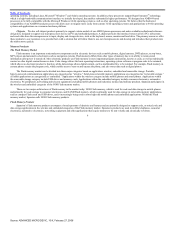AMD 2005 Annual Report Download - page 21
Download and view the complete annual report
Please find page 21 of the 2005 AMD annual report below. You can navigate through the pages in the report by either clicking on the pages listed below, or by using the keyword search tool below to find specific information within the annual report.
Table of Contents
In connection with the formation of Spansion LLC as of June 2003, we and Fujitsu transferred to Spansion various intellectual property rights pursuant to
an Intellectual Property Contribution and Ancillary Matters Agreement, or IPCAAMA. Under the IPCAAMA, Spansion became the owner or joint owner with
each of us and Fujitsu, of certain patents, patent applications, trademarks and other intellectual property rights and technology. We reserved rights, on a royalty
free basis, to practice the contributed patents and to license these patents to our affiliates and successors-in-interest. We also have the right to use the
jointly-owned intellectual property for our internal purposes and to license such intellectual property to others to the extent consistent with our non-competition
obligations to Spansion.
In addition, for as long as our ownership interest in Spansion remains above a specific minimum level, Spansion is required to identify its technology to us
and to provide copies of and training with respect to that technology. Spansion also granted a non-exclusive, perpetual, irrevocable, fully paid and royalty-free
license of its rights in this technology to us. We may grant licenses under Spansion’s patents, provided that these licenses are of no broader scope than, and are
subject to the same terms and conditions that apply to, any license of our patents granted in connection with such license, and the recipient of such license grants
to Spansion a license of similar scope under its patents.
Under the IPCAAMA, for as long as we continue to hold a majority of shares entitled to vote for the election of Spansion’s directors, we must enforce our
applicable patents to minimize, to the extent reasonably possible, any of Spansion’s losses for the infringement of third party patents. However, the manner in
which we enforce our patents, including which patents we enforce, is left to our discretion.
Effective with the closing of Spansion’s IPO, we and Fujitsu transferred additional patents and patent applications to Spansion. The patents that we
transferred included patents and patent applications covering Flash memory products and technology, the processes necessary to manufacture Flash memory
products, and the operation and control of Flash memory products.
We also have a patent cross-license agreement with Fujitsu whereby each party was granted a non-exclusive license under certain of the other party’s
respective semiconductor-related patents. This patent cross-license agreement terminates on June 30, 2013, unless earlier terminated upon 30 days notice
following a change of control of the other party. We also have a patent cross-license agreement with Spansion. The patents and patent applications that are
licensed are those with an effective filing date prior to the termination of the patent cross-license agreement. The agreement will automatically terminate on the
later of June 30, 2013 and the date we sell our entire equity interest in Spansion. The agreements may be terminated by a party on a change in control of the other
party or its semiconductor group.
In addition, as is typical in the semiconductor industry, we have numerous cross-licensing and technology exchange agreements with other companies
under which we both transfer and receive technology and intellectual property rights. One such agreement is the patent cross-license agreement with Intel
Corporation which is effective as of January 1, 2001. Under this agreement we granted each other a non-exclusive license under each party’s patents for the
manufacture and sale of semiconductor products worldwide. We pay Intel a royalty for certain licensed microprocessor products sold by us or any AMD affiliate
anywhere in the world. The license applies to each party’s patents that have a first effective filing date during the capture period, which is the period from
January 1, 2001 through January 1, 2010. Either party may terminate the agreement if the other party commits a material breach of the agreement and does not
correct the breach within 60 days after receiving written notice thereof, In addition, either party may terminate the agreement upon 60 days written notice in the
event of a filing by the other party of a petition in bankruptcy or insolvency, or any adjudication thereof, the filing of any petition seeking reorganization under
any law relating to bankruptcy, the appointment of a receiver, the making of any assignment for the benefit of creditors, the institution of any proceedings for the
liquidation or winding up of the other party’s business, or in the event of a change of control. For purposes of our agreement with Intel, change of control means
a transaction or a series of related transactions in which (i) one or more related parties who did not previously own at least a 50 percent interest in a party obtain
at least a 50 percent interest in such party, and, in the
16
Source: ADVANCED MICRO DEVIC, 10-K, February 27, 2006
























